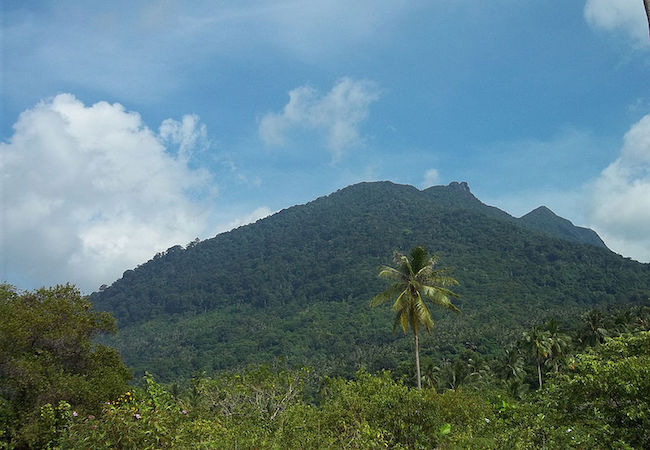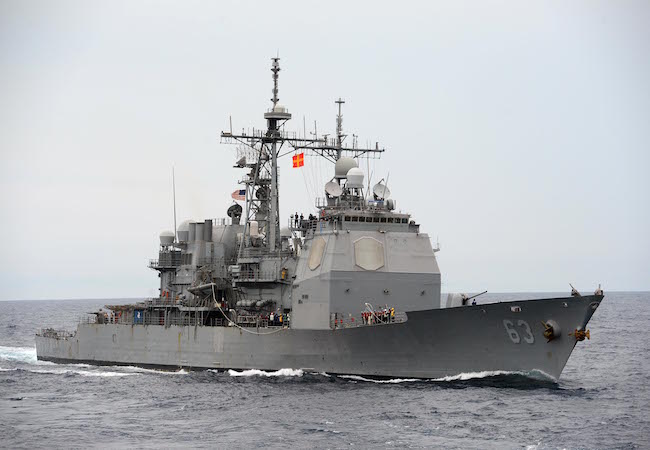
By Dr. Abdul Ruff
Even as China claims most of the South China Sea where it has been building islands, Indonesia has formally protested to China over an infringement of its waters. On June 18 an Indonesian patrol ship attempted to detain a Chinese fishing boat it says was fishing illegally in the Natuna Sea of Indonesia. But it was prevented from doing so by the Chinese coastguard. Eight crew members of the fishing vessel Kway Fey were detained, however.
Natuna is the furthermost island in Indonesia, and it’s on our border in the South China Sea. Natuna Island is located up north in the South China Sea and the potential conflict zone where China’s nine-dash line and Indonesia’s exclusive economic zone off the coast of Natuna overlap.
While Chinese fishing boats and their coastguard escorts were encroaching deeper into Indonesia’s exclusive economic zone, it was not clear how far this was driven by strategic as opposed to commercial objectives.
Chinese fishing fleets, whether directed by the state or not, are going further and further south because they have overfished the waters near Hainan. It may also be strategically driven because Indonesia has stepped up fisheries enforcement in the Natuna Sea and China may want to send a message that it won’t be pushed around.”
It is unclear whether the fishermen are still being detained by Indonesian authorities.
China claims most of the South China Sea, where it is building islands and extending its infrastructure, and there are often flare-ups with regional neighbours with competing claims. Indonesia would release them sooner than later since, unlike other South East Asian countries, Indonesia is not involved in the territorial disputes in the South China Sea.
China accepts the Natuna islands and the seas around them belong to Indonesia, but the two sides have confronted one another there before, typically over illegal fishing.
Friday’s incident was the third altercation between Indonesia and China in waters near Natuna this year. In March, Indonesia lodged an official protest after an Indonesian patrol ship tried to detain a Chinese fishing boat in the Natuna Sea, but was prevented from doing so by the Chinese coastguard.
China’s acting charge d’affaires in Jakarta Sun Weide demanded the release of the crew, saying the incident occurred in “traditional Chinese fishing grounds”. Sun told press “When it comes to fishery disputes, or maritime issues, China is always ready to work with Indonesia to solve these disputes trough negotiations and dialogue.” Unlike other South-east Asian countries, Indonesia is not involved in the territorial disputes in the South China Sea. After meeting with Chinese embassy officials on June 20, Indonesia’s Foreign Minister Retno Marsudi said: “At the meeting we conveyed our strong protest over the breach by the Chinese coastguard of Indonesia’s sovereign rights.”
Indonesia said it’s obvious how much that stability of Natuna is prized among the local population. This island is a picturesque, idyllic place – but it stands on the frontline of a potential clash between Indonesia and China.
Meanwhile, China has accused the Indonesian Navy of opening fire on a Chinese fishing boat in disputed fishing grounds. China’s foreign ministry said on Sunday that one fisherman was injured and several detained. The incident happened on Friday near the Natuna islands, off the coast of Borneo in the South China Sea. A spokeswoman for the Chinese foreign ministry described Indonesia’s actions as an “indiscriminate use of force”, adding: “We urge the Indonesian side to refrain from any action that complicates or magnifies the dispute, or impacts the peace and stability of the region.” The ministry said the incident had happened in a “traditional Chinese fishing ground”.
The Indonesian Navy said it had fired warning shots on Friday at Chinese fishing boats operating in the Natuna Sea, in Indonesia’s exclusive economic zone, the third such confrontation reported this year. Indonesian Vice-President Jusuf Kalla said that China would be asked to respect his country’s sovereignty around the islands. “This is not a clash, but we are protecting the area,” Kalla said. Indonesian Fisheries Minister Susi Pudjiastuti said that the navy “made the right move by maintaining the sovereignty of our seas”. “Stealing fish is a crime,” she said.
China’s foreign ministry said that one boat had been damaged and one sailor shot and injured during the altercation, which it said occurred in “traditional Chinese fishing grounds”. Beijing and Jakarta have tried to play down their maritime differences over the past two decades but the recent run of incidents and hardening rhetoric from China are undermining that stance. Indonesia’s government insists that Indonesia and China won’t clash over the South China Sea, and that the two nations will solve Although the possibility may seem remote at the moment, Indonesia has to balance its interests delicately while making sure it keeps its borders safe.
China’s “nine-dash line” claim to almost the entire South China Sea cuts through Indonesia’s exclusive economic zone in the Natuna Sea, although Beijing has accepted that Jakarta has sovereignty over the Natuna islands themselves. China’s foreign ministry said the latest incident occurred in waters “where China and Indonesia have overlapping claims for maritime rights and interests”, suggesting its ambitions in the gas-rich Natuna Sea stretch beyond mere “fishing grounds”. “This is the first time in a long time that China is openly declaring that there are overlapping maritime claims. If China is enforcing its maritime claims, it becomes harder for Indonesia to maintain its neutrality.
Jakarta has long maintained that this does not amount to a territorial dispute because China has never formally clarified its nine-dash line claim under international law. But the spike in fisheries clashes, which have occurred ever closer to Indonesia’s territorial waters, has angered some within the Indonesian government.
South China Sea
The South China Sea is a contested waterway – China, Malaysia, the Philippines and Vietnam all lay claim to it. Indonesia says it has no territorial interests in these waters – but look closely at the map, and it’s a different story.
A series of violent fisheries clashes with China is adding to domestic pressure on Indonesia’s government to take a tougher stance towards Beijing, with which it routinely claims to have no maritime disputes. The latest clash comes at a testing time for the region, with Southeast Asian nations deeply divided over how to respond to Beijing’s assertive approach. Tensions are set to rise further in the coming weeks, when an international court in The Hague is expected to rule on a case brought against China’s maritime claims by the Philippines. Susi Pudjiastuti, Indonesia’s fisheries minister said that shots were fired “according to procedure” as the navy defended Indonesia’s sovereignty.
China is locked in a dispute with several countries over maritime claims in the South China Sea. China says its land reclamation work in the South China Sea is “totally justifiable” as it has “sovereignty” over the area. Its foreign affairs ministry spokesman Hua Chunying was responding to the issue of China’s construction work in disputed waters. In May the Philippines released photos appearing to show Chinese land reclamation on Johnson South reef, saying China appeared to be building an airstrip. Aside from the Philippines, Vietnam, Brunei, Malaysia and Taiwan also have competing claims with China over various islands, reefs and shoals in the region.
Separately, relations between China and Japan are also currently under strain over a territorial row involving islands in the East China Sea. The Philippines has accused China of illegal building in the area. China is reportedly building new islands on five different reefs. Chinese work is progressing to dredge tonnes of rock and sand from the sea floor to pump into Johnson South reef in the Spratly islands, which are also claimed by Manila. The works appear to have been going on for months. They are privately calling for President Joko Widodo, , who has largely side-stepped foreign policy to focus on boosting the economy and has shown a reluctance to upset China, to abandon the country’s neutrality on regional maritime disputes and lend more support to neighbours such as Vietnam and the Philippines, which have stood up to China more forcefully.
China also asserts indisputable sovereignty over the Nansha Islands and the adjacent waters, and China’s activities on relevant islands and reefs of the Nansha Islands fall entirely within China’s sovereignty and are totally justifiable.” Asked whether the reclamation was for commercial or military use, Chinese foreign affairs ministry spokesman Ms Hua Chunying replied that it was “mainly for the purpose of improving the working and living conditions of people stationed on these islands”.
China has been building artificial islands in the Spratly Islands on top of reefs and atolls to bolster its claims and to gain fishing and resource rights to most of the South China Sea.
More recently, the Chinese have signaled they may begin construction of a new island atop Scarborough Shoal, which lies only 140 miles from the Philippines’ capital. An international court is set to rule soon on this dispute. The looming decision, along with stepped-up US patrols, has led to mounting tensions in the disputed region.

USA steps in
The USA has sent a strong message to China by putting into operation its Navy destroyers in South China Sea, the world’s most contested body of water. US Naval destroyer Stennis left the South China Sea on June 5 after arriving in early April in what was intended as a demonstration of the U.S. commitment to the region after aggressive moves and island-building by China raised concerns among U.S. allies and partners there. The months-long patrol was shadowed almost the entire time by People’s Liberation Army-Navy vessels, and certainly raised the ire of Beijing. In May, the Chinese government cancelled a port visit in Hong Kong, saying it was “inconvenient” for the flattop to pull in.
Not long after departing the South China Sea, the Stennis participated in a massive show of force in the Philippine Sea as it rendezvoused with carrier Ronald Reagan. In a release, Navy Task Force 70 headlined the dual carrier flight operations as “Two carrier strike groups double down in Western Pacific,” noting that this showcases “United States unique capability to operate multiple carrier strike groups in close proximity.”
During the three months, Stennis frequently became a symbol of the U.S. response to increasingly aggressive Chinese moves across the region. China claims nearly all of the South China Sea as its sovereign territory and has reinforced its claims by constructing man-made islands on rocky outcroppings, reefs and atolls in the region. Its neighbors claim China is bullying them, and the USA has opposed what it sees as China’s coercive tactics to enforce its claims.




